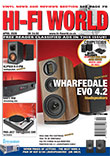Page 1 of 2 A Few Taps More Chord Electronics release a unique product – M Scaler. It's a one-million tap digital filter that transforms CD, they say. Noel Keywood listens.
To celebrate producing a one million tap digital filter Chord Electronics have released M Scaler. M Scaler isn’t a product you’ll find elsewhere, even though upscaling is not a new idea. However, M Scaler doesn’t just upscale, it also possesses a Watts Transient Aligned (WTA) filter in its most advanced ever state because of those milestone one million taps. That’s what you pay £3495 for. And trust it will produce better sound! To clarify the purpose of this product, it is to get the very best from CD, by first scaling up sample rate from the low 44.1kHz – necessary in 1982 when Philips and Sony were developing CD – to 705.6kHz that will run on today’s silicon. Then the stream is passed through the WTA filter and on to an array of outputs. There are standard S/PDIF digital outputs in the form of one electrical via a BNC socket, and one optical via a TOSLINK socket, for connection to an external DAC. This can be any DAC, not just one from Chord Electronics – if with limitations I’ll explain later. For Hugo TT2 and other Chord Electronics products there is also a Dual BNC (DBNC) output pair that outputs at the full 768kHz sample rate. Input wise, there are two electrical BNC socket inputs, two TOSLINK opticals and one galvanically isolated USB for connection to a computer. Both a front panel spherical button (2nd from left) or the remote control can be used to step between inputs, the button changing colour to show selection. Output sample rate is set by an illuminated spherical button third-in from left. Lit red the unit is set to bypass, then with CD x2 upsample to 88.2kHz is green, x4 to 176.4kHz is blue and max upscale of x16 to 705.6kHz is white. Now on to practicalities. M Scaler as a real world product must feed external commercial DACs and at present most DAC chips work up to but not higher than 768kHz; older designs 352.8kHz. So whatever goes into M Scaler must come out at a sample rate that suits such DACs, meaning you can’t input 24/96 hi-res and upscale x16 to a sizzling 1.5MHz ‘cos there’s no DAC out there able to take it – and cables become an issue too. Consequently, with a 96kHz input M Scaler upscales x8 to 768kHz max, but only through its DBNC output sockets to feed Chord Electronics products like Hugo TT2 with a matching DBNC input. The single BNC outlet for other DACs is limited to 384kHz under all conditions so as to suit both their DAC chips and commercial interconnect cables.
At left, two gold plated BNC digital inputs, two optical inputs and a USB for computer connection (centre). Then optical and BNC outputs, and right twin DBNC outputs for Chord Electronics products with matching DBNC inputs.
I mention cables because optical TOSLINK cables barely work past 96kHz, not just because of internal losses and low bandwidth of the cheap plastic optical conductor, but also because of imprecise termination in TOSLINK sockets – wiggle ‘em at high sample rates and see what happens! So the optical output of M Scaler is restricted to 192kHz for entirely practical reasons. The data still passes through the WTA filter but Chord Electronics disarmingly indicate in a chart within M Scaler’s handbook that there’s no sound quality improvement, except when blue (x2) is selected (why white also at x2 gives no improvement I have no idea). To summarise simply, M Scaler works best with CD and 48kHz sample rate files, with output taken from the DBNC socket-pair to a Chord Electronics DAC with DBNC input. Queried about the special DBNC connection, Rob Watts told me it is an AES S/PDIF dual-mono mode with changes to the data bits to flag this status. DBNC does not bypass all Hugo TT2’s filters by the way; the first of three stages is bypassed, the second two stages remain active.
Like Hugo TT2, build and finish of M Scaler is impressive, its case being machined from solid alloy, making it wonderfully strong and with superb contours and detailing. Case dimension are 235mm wide, 236mm deep and 40.5mm high, with weight of 2.55kgs.
Power is supplied by the same Chinese external switch-mode power supply block used with Hugo TT2, delivering 15V at a high 4A through a cable 335cms (11ft) long in total. There is a video mode that reduces filter time delay (0.6secs) so speech synchronises with the picture, achieving this by reducing the number of filter taps. The USB input did not accept DSD from my MacBook Pro laptop running Audirvana, that is packaged as DoP code. It may accept native DSD from a PC, but you can’t get a Mac to do this. M Scaler is about improving PCM, not reproducing DSD. |
Search
Hi-Fi World, Powered by Joomla!; Hosted by Joomla Wired.






